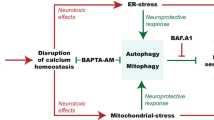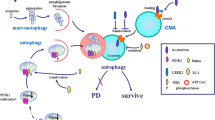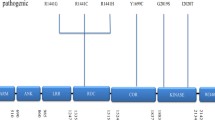Abstract
Parkinson’s disease (PD) is a common neurodegenerative disorder whose symptoms are consistent with death of dopaminergic neurons in the substantia nigra of the brain. The pathogenesis of PD involves several factors, such as α-synuclein aggregation, oxidative stress, mitochondrial dysfunction, and activation of apoptosis, but the exact molecular mechanism of neurodegeneration remains obscure. PD is usually sporadic, while rare monogenic forms have been identified and described in the past 15 years. Familial Parkinson’s disease is most commonly associated with mutations of the leucine repeat-rich kinase 2 gene (LRRK2). The mechanism of the disease due to LRRK2 mutations is unknown. The signaling cascades regulated by LRRK2 are difficult to study because the physiological substrates of the enzyme are unidentified. The G2019S substitution has been found to be the most common LRRK2 mutation, facilitating a search for patients with LRRK2-associated PD in various populations. The review considers the effects of LRRK2 mutations on protein and, in particular, α-synuclein aggregation, cytoskeletal dynamics, the inflammatory response, and the induction of apoptosis as revealed in both in vitro experiments and studies in PD patients. Investigation of rare hereditary PD forms with known etiology provides for a better understanding of the mechanism of neurodegeneration in more common sporadic PD forms.
Similar content being viewed by others
References
Illarioshkin S.N. 2002. Konformatsionnye bolezni mozga (Conformational Diseases of the Brain). Moscow: Yanus-K.
Shadrina M.I., Slominsky P.A. 2008. Mitochondrial dysfunction and oxidative damage in the molecular pathology of Parkinson’s disease. Mol. Biol. (Moscow). 42, 720–728.
Cookson M.R., Bandmann O. 2010. Parkinson’s disease: Insights from pathways. Hum. Mol. Genet. 19(R1), R21–R27.
Levy O.A., Malagelada C., Greene L.A. 2009. Cell death pathways in Parkinson’s disease: Proximal triggers, distal effectors, and final steps. Apoptosis. 14(4), 478–500.
Mizushima N., Levine B., Cuervo A.M., Klionsky D.J. 2008. Autophagy fights disease through cellular selfdigestion. Nature. 451(7182), 1069–1075.
Bekris L.M., Mata I.F., Zabetian C.P. 2010. The genetics of Parkinson’s disease. J. Geriatr. Psychiatry Neurol. 23, 228–242.
Hardy J. 2010. Genetics analysis of pathways to Parkinson’s disease. Neuron. 68, 201–206.
Ozelius L.J., Senthil G., Suanders-Pullman R., Ohmann E., Deligtisch A., Tagliati M., Hunt A.L., Klein C., Henick B., Hailpern S.M., Lipton R.B., Soto-Valencia J., Risch N., Bressman S. 2006. LRRK2 G2019S as a cause of Parkinson’s disease in Ashkenazi Jewish. N. Engl. J. Med. 354, 424–425.
Lesage S., Dürr A., Tazir M., Lohmann E., Leutenegger A.L., Janin S., Pollak P., Brice A., French Parkinson’s Disease Genetics Study Group. 2006. LRRK2 G2019S as a cause of Parkinson’s disease in North African Arabs. New Engl. J. Med. 354, 422–423.
Funayama M., Hasegawa K., Kowa H., Saito M., Tsuji S., Obata F. 2002. A new locus for Parkinson’s disease (PARK8) maps to chromosome 12p11.2–p13.1. Ann. Neurol. 51, 296–301.
Paisan-Ruiz C., Jain S., Evans E.W., Gilks W., Simón J., van der Brug M., de Munain A., Aparicio S., Gil A., Khan N. 2004. Cloning of the gene containing mutations that cause PARK8-linked Parkinson’s disease. Neuron. 44, 595–600.
Zimprich A., Biskup S., Leitner P., Farrer M., Lincoln S., Kachergus J., Hulihan M., Uitti R., Calne D. 2004. Mutations in LRRK2 cause autosomal-dominant parkinsonism with pleomorphic pathology. Neuron. 44, 601–607.
Greggio E., Cookson M.R. 2009. Leucine-rich repeat kinase 2 mutations and Parkinson’s disease: Three questions. ASN Neuro. 1(1), e00002.
Greggio E. 2012. Role of LRRK2 kinase activity in the pathogenesis of Parkinson’s disease. Biochem. Soc. Trans. 40(5), 1058–1062.
Giasson B.I., van Deerlin V.M. 2008. Mutations in LRRK2 as a cause of Parkinson’s disease. Neurosignals. 16, 99–105.
Tan E.K., Shen H., Tan L.C., Farrer M., Yew K., Chua E., Jamora R.D., Puvan K., Puong K.Y., Zhao Y., Pavanni R., Wong M.C., Yih Y., Skipper L., Liu J.J. 2005. Lack of G2019S LRRK2 mutation in a cohort of Taiwanese with sporadic Parkinson’s disease. Neurosci. Lett. 384(3), 327–329.
Fung H.C., Chen C.M., Hardy J., Hernandez D., Singleton A., Wu Y.R. 2006. Lack of G2019S LRRK2 mutation in a cohort of Taiwanese with sporadic Parkinson’s disease. Mov. Disord. 21, 880–881.
Shulman J.M., DeJager P.L., Feany M.B. 2011. Parkinson’s disease: Genetics and pathogenesis. Ann. Rev. Pathol. Mech. 6, 193–222.
Lee E., Hui S., Ho G., Tan E.K., Chen C.P. 2006. LRRK2 G2019S and I2020T mutations are not common in Alzheimer’s disease and vascular dementia. Am. J. Med. Genet. B Neuropsychiatr. Genet. 141B(5), 549–550.
Whittle A.J., Ross O.A., Naini A., Gordon P., Mistumoto H., Dächsel J.C., Stone J.T., Wszolek Z.K., Farrer M.J., Przedborski S. 2007. Pathogenic Lrrk2 substitutions and amyotrophic lateral sclerosis. J. Neural Transm. 114(3), 327–329.
Chang T.Y., Kuo H.C., Lu C.S., Wu-Chou Y.H., Huang C.C. 2010. Analysis of the LRRK2 Gly2385Arg variant in Alzheimer’s disease in Taiwan. Parkinson. Relat. Disord. 1, 28–30.
Lesage S., Brice A. 2009. Parkinson’s disease: From monogenic forms to genetic susceptibility factors. Hum. Mol. Genet. 18(R1), R48–R45.
Simón-Sánchez J., Martí-Massó J.F., Sánchez-Mut J.V., Paisán-Ruiz C., Martínez-Gil A., Ruiz-Martínez J., Sáenz A., Singleton A.B., López de Munain A., PérezTur J. 2006. Parkinson’s disease due to the R1441G mutation in Dardarin: A founder effect in the Basques. Mov. Disord. 21(11), 1954–1959.
Pchelina S.N., Yakimovskii A.F., Emelyanov A.K., Ivanova O.N., Schwarzman A.L., Singleton A.B. 2008. Screening for LRRK2 mutations in patients with Parkinson’s disease in Russia: Identification of a novel LRRK2 variant. Eur. J. Neurol. 5, 692–696.
Pchelina S.N., Ivanova O.N., Emelyanov A.K., Yakimovskii A.F., Schwarzman A.L. 2006. LRRK2 mutations in patients with Parkinson’s disease in Russia. Med. Genet. 5(2), 48–51.
Pchelina S.N., Yakimovskii A.F., Ivanova O.N., Emelianov A.K., Zakharchuk A.H., Schwarzman A.L. 2006. G2019S LRRK2 mutation in familial and sporadic Parkinson’s disease in Russia. Mov. Disord. 21(12), 2234–2236.
Pchelina S.N., Ivanova O.N., Emelianov A.K., Yakimovskii A.F. 2011. Clinical progression of LRRK2-associated Parkinson’s disease. Zh. Nevrol. Psikhiatr. im. S.S. Korsakova. 111(12), 56–62.
Paisan-Ruiz C., Lang A.E., Kawarai T., Sato C., Salehi-Rad S., Fisman G.K., Al-Khairallah T., St. George-Hyslop P., Singleton A., Rogaeva E. 2005. LRRK2 gene in Parkinson’s disease: Mutation analysis and case control association study. Neurology. 65(5), 696–700.
Lesage S., Belarbi S., Troiano A., Condroyer C., Hecham N., Pollak P., Lohman E., Benhassine T., Ysmail-Dahlouk F., Dürr A., Tazir M., Brice A; French Parkinson’s Disease Genetics Study Group. 2008. Is the common LRRK2 G2019S mutation related to dyskinesias in North African Parkinson disease? Neurology. 71(19), 1550–1552.
Nishioka K., Kefi M., Jasinska-Myga B., Wider C., Vilariño-Güell C., Ross O.A., Heckman M.G., Middleton L.T., Ishihara-Paul L., Gibson R.A., Amouri R., Ben Yahmed S., Ben Sassi S., Zouari M., El Euch G., Farrer M.J., Hentati F. 2010. A comparative study of LRRK2, PINK1 and genetically undefined familial Parkinson’s disease. J. Neurol. Neurosurg. Psychiatry. 81(4), 391–395.
Greggio E., Zambrano I., Kaganovich A., Beilina A., Taymans J.M., Daniels V., Lewis P., Jain S., Ding J., Syed A., Thomas K.J., Baekelandt V., Cookson M.R. 2008. The Parkinson disease-associated leucine-rich repeat kinase 2 (LRRK2) is a dimer that undergoes intramolecular autophosphorylation. J. Biol. Chem. 283, 16906–16914.
Hsu C.H., Chan D., Wolozin B. 2010. LRRK2 and the stress response: Interaction with MKKs and JNK-interacting proteins. Neurodegener. Dis. 7(1–3), 68–75.
Smith W.W., Pei Z., Jiang H., Dawson V.L., Dawson T.M., Ross C.A. 2006. Kinase activity of mutant LRRK2 mediates neuronal toxicity. Nature Neurosci. 9, 1231–1233.
Jaleel M., Nichols R.J., Deak M., Campbell D.G., Gillardon F., Knebel A., Alessi D.R. 2007. LRRK2 phosphorylates moesin at threonine-558: characterization of how Parkinson’s disease mutants affect kinase activity. Biochem. J. 405, 307–317.
West A.B., Moore D.J., Choi C., Andrabi S.A., Li X., Dikeman D., Biskup S., Zhang Z., Lim K.L., Dawson V.L., Dawson, T.M. 2007. Parkinson’s diseaseassociated mutations in LRRK2 link enhanced GTP-binding and kinase activities to neuronal toxicity. Hum. Mol. Genet. 16, 223–232.
Xiong Y., Coombes C.E., Kilaru A., Li X., Gitler A.D., Bowers W.J., Dawson V.L., Dawson T.M., Moore D.J. 2010. GTPase activity plays a key role in the pathobiology of LRRK2. PLoS Genet. 6(4), e1000902.
Cookson M.R. Cellular effects of LRRK2 mutations. 2012. Biochem. Soc. Trans. 40(5), 1070–1073.
Macleod D., Dowman J., Hammond R., Leete T., Inoue K., Abeliovich A. 2006. The familial Parkinsonism gene LRRK2 regulates neurite process morphology. Neuron. 52(4), 587–593.
Lee B.D., Shin J.H., VanKampen J., Petrucelli L., West A.B., Ko H.S., Lee Y.I., Maguire-Zeiss K.A., Bowers W.J., Federoff H.J., Dawson V.L., Dawson T.M. 2010. Inhibitors of leucine-rich repeat kinase-2 protect against models of Parkinson’s disease. Nature Med. 16(9), 998–1000.
Daniëls V., Vancraenenbroeck R., Law B.M., Greggio E., Lobbestael E., Gao F., De Maeyer M., Cookson M.R., Harvey K., Baekelandt V., Taymans J.M. 2011. Insight into the mode of action of the LRRK2 Y1699C pathogenic mutant. J. Neurochem. 116(2), 304–315.
Rudenko I.N., Kaganovich A., Hauser D.N., Beylina A., Chia R., Ding J., Maric D., Jaffe H., Cookson M.R. 2012. The G2385R variant of leucine-rich repeat kinase 2 associated with Parkinson’s disease is a partial loss-of-function mutation. Biochem. J. 446(1), 99–111.
Spillantini M.G., Schmidt M.L., Lee V.M.Y., Trojanowski J.Q., Jakes R., Goedert M. 1997. Alpha-synuclein in Lewy bodies. Nature. 388, 839–840.
Cookson M.R. 2010. The role of leucine-rich repeat kinase 2 (LRRK2) in Parkinson’s disease. Nature Rev. Neurosci. 11(12), 791–797.
Fujiwara H., Hasegawa M., Dohmae N., Kawashima A., Masliah E., Goldberg M.S., Shen J., Takio K., Iwatsubo T. 2002. Alpha-synuclein is phosphorylated in synucleinopathy lesions. Nature Cell Biol. 4(2), 160–164.
Alegre-Abarrategui J., Ansorge O., Esiri M., WadeMartins R. 2008. LRRK2 is a component of granular alpha-synuclein pathology in the brainstem of Parkinson’s disease. Neuropathol. Appl. Neurobiol. 34(3), 272–283.
Vitte J., Traver S., Maues De Paula A., Lesage S., Rovelli G., Corti O., Duyckaerts C., Brice A. 2010. Leucine-rich repeat kinase 2 is associated with the endoplasmic reticulum in dopaminergic neurons and accumulates in the core of Lewy bodies in Parkinson disease. J. Neuropathol. Exp. Neurol. 69(9), 959–972.
Qing H., Wong W., McGeer E.G., McGeer P.L. 2009. LRRK2 phosphorylates alpha synuclein at serine 129: Parkinson disease implications. Biochem. Biophys. Res. Commun. 387(1), 149–152.
Nichols R.J., Dzamko N., Morrice N.A., Campbell D.G., Deak M., Ordureau A., Macartney T., Tong Y., Shen J., Prescott A.R., Alessi D.R. 2010. 14-3-3 binding to LRRK2 is disrupted by multiple Parkinson’s diseaseassociated mutations and regulates cytoplasmic localization. Biochem. J. 430(3), 393–404.
Dzamko N., Deak M., Hentati F., Reith A.D., Prescott A.R., Alessi D.R., Nichols R.J. 2010. Inhibition of LRRK2 kinase activity leads to dephosphorylation of Ser(910)/Ser(935), disruption of 14-3-3 binding and altered cytoplasmic localization. Biochem. J. 430(3), 405–413.
Lin X., Parisiadou L., Gu X.L., Wang L., Shim H., Sun L., Xie C., Long C.X., Yang W.J., Ding J., Chen Z.Z., Gallant P.E., Tao-Cheng J.H., Rudow G., Troncoso J.C., Liu Z., Li Z., Cai H. 2009. Leucine-rich repeat kinase 2 regulates the progression of neuropathology induced by Parkinson’s-disease-related mutant alpha-synuclein. Neuron. 64(6), 807–827.
Li Y., Liu W., Oo T.F., Wang L., Tang Y., Jackson-Lewis V., Zhou C., Geghman K., Bogdanov M., Przedborski S., Beal M.F., Burke R.E., Li C. 2009. Mutant LRRK2 (R1441G) BAC transgenic mice recapitulate cardinal features of Parkinson’s disease. Nature Neurosci. 12(7), 826–828.
Shin N., Jeong H., Kwon J., Heo H.Y., Kwon J.J., Yun H.J., Kim C.H., Han B.S., Tong Y., Shen J., Hatano T., Hattori N., Kim K.S., Chang S., Seol W. 2008. LRRK2 regulates synaptic vesicle endocytosis. Exp. Cell Res. 314(10), 2055–2065.
Parisiadou L., Xie C., Cho H.J., Lin X., Gu X.L., Long C.X., Lobbestael E., Baekelandt V., Taymans J.M., Sun L., Cai H. 2009. Phosphorylation of ezrin/radixin/moesin proteins by LRRK2 promotes the rearrangement of actin cytoskeleton in neuronal morphogenesis. J. Neurosci. 29(44), 13971–13980.
Gillardon F. 2009. Leucine-rich repeat kinase 2 phosphorylates brain tubulin-beta isoforms and modulates microtubule stability: A point of convergence in parkinsonian neurodegeneration? J. Neurochem. 110(5), 1514–1522.
Melrose H.L., Dächsel J.C., Behrouz B., Lincoln S.J., Yue M., Hinkle K.M., Kent C.B., Korvatska E., Taylor J.P., Witten L., Liang Y.Q., Beevers J.E., Boules M., Dugger B.N., Serna V.A., Gaukhman A., Yu X., Castanedes-Casey M., Braithwaite A.T., Ogholikhan S., Yu N., Bass D., Tyndall G., Schellenberg G.D., Dickson D.W., Janus C., Farrer M.J. 2010. Impaired dopaminergic neurotransmission and microtubule-associated protein tau alterations in human LRRK2 transgenic mice. Neurobiol. Dis. 40(3), 503–517.
Covy J.P., Yuan W., Waxman E.A., Hurtig H.I., van Deerlin V.M., Giasson B.I. 2009. Clinical and pathological characteristics of patients with leucine-rich repeat kinase-2 mutations. Mov. Disord. 24(1), 32–39.
Taymans J., Cookson M.R. 2010. Mechanisms in dominant parkinsonism: The toxic triangle of LRRK2, alpha-synuclein, and tau. BioEssays. 32, 227–235.
Tong Y., Yamaguchi H., Giaime E., Boyle S., Kopan R., Kelleher R.J., Shen J. 2010. Loss of leucine-rich repeat kinase 2 causes impairment of protein degradation pathways, accumulation of alpha-synuclein, and apoptotic cell death in aged mice. Proc. Natl. Acad. Sci. U. S. A. 107(21), 9879–9884.
Alegre-Abarrategui J., Christian H., Lufino M., Mutihac R., Venda L.L., Ansorge O., Wade-Martins R. 2009. LRRK2 regulates autophagic activity and localizes to specific membrane microdomains in a novel human genomic reporter cellular model. Hum. Mol. Genet. 18(21), 4022–4034.
Plowey E.D., Cherra S.J. 3rd, Liu Y.J., Chu C.T. 2008. Role of autophagy in G2019S-LRRK2-associated neurite shortening in differentiated SH-SY5Y cells. J. Neurochem. 105(3), 1048–1056.
White L.R., Toft M., Kvam S.N., Farrer M.J., Aasly J.O. 2007. MAPK-pathway activity, Lrrk2 G2019S, and Parkinson’s disease. J. Neurosci. Res. 85, 1288–1294.
Pchelina S.N., Emelyanov A.K., Yakimovskii A.F., Miller D.W., Shabalina I.G., Drozdova A.S., Schwarzman A.L. 2010. Reduced content of α-synuclein in peripheral blood leukocytes of patients with LRRK2-associated Parkinson’s disease. Bull. Exp. Biol. Med. 150(6), 679–681.
Andoskin P.A., Emelyanov A.K., Yakimovsky A.F., Timofeeva A.A., Pchelina S.N. 2013. Oligomeric alpha-synuclein levels in blood plasma in LRRK2-linked Parkinson’s disease. J. Hum. Genet. 21(Suppl. 2), 513.
Gorostidi A., Bergareche A., Ruiz-Martínez J., MartiMassó J.F., Cruz M., Varghese S., Qureshi M.M., Alzahmi F., Al-Hayani A., de Munáin A.L., El-Agnaf O.M. 2012. α-Synuclein levels in blood plasma from LRRK2 mutation carriers. PLoS ONE. 7(12), e52312.
Park M.J., Cheon S.M., Bae H.R., Kim S.H., Kim J.W. 2011. Elevated levels of α-synuclein oligomer in the cerebrospinal fluid of drug-naïve patients with Parkinson’s disease. J. Clin. Neurol. 7(4), 215–222.
Foulds P.G., Mitchell J.D., Parker A., Turner R., Green G., Diggle P., Hasegawa M., Taylor M., Mann D., Allsop D. 2011. Phosphorylated α-synuclein can be detected in blood plasma and is potentially a useful biomarker for Parkinson’s disease. FASEB J. 25(12), 4127–4137.
Pchelina S.N. 2011. Alpha-synuclein as a biomarker of Parkinson’s disease. Ann. Klin. Eksp. Nevrol. 6, 46–51.
Zhao Y., Ho P., Yih Y., Chen C., Lee W.L., Tan E.K. 2011. LRRK2 variant associated with Alzheimer’s disease. Neurobiol. Aging. 32(11), 1990–1993.
Li H.L., Lu S.J., Sun Y.M., Guo Q.H., Sadovnick A.D., Wu Z.Y. 2013. The LRRK2 R1628P variant plays a protective role in Han Chinese population with Alzheimer’s disease. CNS Neurosci. Ther. 19(4), 207–215.
Greggio E., Civiero L., Bisaglia M., Bubacco L. 2012. Parkinson’s disease and immune system: Is the culprit LRRKing in the periphery? J. Neuroinflamm. 9, 94.
Hakimi M., Selvanantham T., Swinton E., Padmore R.F., Tong Y., Kabbach G., Venderova K., Girardin S.E., Bulman D.E., Scherzer C.R., LaVoie M.J., Gris D., Park D.S., Angel J.B., Shen J., Philpott D.J., Schlossmacher M.G. 2011. Parkinson’s disease-linked LRRK2 is expressed in circulating and tissue immune cells and upregulated following recognition of microbial structures. J. Neural Transm. 118(5), 795–808.
Gardet A., Benita Y., Li C., Sands B.E., Ballester I., Stevens C., Korzenik J.R., Rioux J.D., Daly M.J., Xavier R.J., Podolsky D.K. 2010. LRRK2 is involved in the IFN-gamma response and host response to pathogens. J. Immunol. 185(9), 5577–5585.
Schroder K., Hertzog P.J., Ravasi T., Hume D.A. 2004. Interferon-gamma: An overview of signals, mechanisms and functions. J. Leukoc. Biol. 75(2), 163–189.
Liu Z., Lee J., Krummey S., Lu W., Cai H., Lenardo M.J. 2011. The kinase LRRK2 is a regulator of the transcription factor NFAT that modulates the severity of inflammatory bowel. Nature Immunol. 12(11), 1063–1070.
Gillardon F., Schmid R., Draheim H. 2012. Parkinson’s disease-linked leucine-rich repeat kinase 2 (R1441G) mutation increases proinflammatory cytokine release from activated primary microglial cells and resultant neurotoxicity. Neuroscience. 208, 41–48.
Moehle M.S., Webber P.J., Tse T., Sukar N., Standaert D.G., DeSilva T.M., Cowell R.M., West A.B. 2012. LRRK2 inhibition attenuates microglial inflammatory responses. J. Neurosci. 32(5), 1602–1611.
Iaccarino C., Crosio C., Vitale C., Sanna G., Carrì M.T., Barone P. 2007. Apoptotic mechanisms in mutant LRRK2-mediated cell death. Hum. Mol. Genet. 16(11), 1319–1326.
Milosevic J., Schwarz S.C., Ogunlade V., Meyer A.K., Storch A., Schwarz J. 2009. Emerging role of LRRK2 in human neural progenitor cell cycle progression, survival and differentiation. Mol. Neurodegener. 4, 25.
Ho C.C., Rideout H.J., Ribe E., Troy C.M., Dauer W.T. 2009. The Parkinson disease protein leucine-rich repeat kinase 2 transduces death signals via Fas-associated protein with death domain and caspase-8 in a cellular model of neurodegeneration. J. Neurosci. 29(4), 1011–1016.
Vila M., Ramonet D., Perier C. 2008. Mitochondrial alterations in Parkinson’s disease: New clues. J. Neurochem. 107(2), 317–328.
Ohta E., Kubo M., Obata F. 2010. Prevention of intracellular degradation of I2020T mutant LRRK2 restores its protectivity against apoptosis. Biochem. Biophys. Res. Commun. 391(1), 242–247.
Usenko T.S., Emelyanov A.K., Yakimovskii A.F., Bogankova N.A., Vavilova T.V., Schwarzman A.L., Pchelina S.N. 2012. Apoptosis of peripheral blood lymphocytes in patients with LRRK2-associated Parkinson’s disease. Cell Tissue Biol. 6(2), 171–175
Gómez-Suaga P., Fdez E., Blanca Ramírez M., Hilfiker S. 2012. A link between autophagy and the pathophysiology of LRRK2 in Parkinson’s disease. Parkinson’s Dis. 2012, 324521. doi 10.1155/2012/324521
Saunders-Pullman R., Barrett M.J., Stanley K.M., Luciano M.S., Shanker V., Severt L., Hunt A., Raymond D., Ozelius L.J., Bressman S.B. 2010. LRRK2 G2019S mutations are associated with an increased cancer risk in Parkinson disease. Mov. Disord. 25(15), 2536–2541.
Bandmann O., Cookson M.R. 2012. Parkinson disease, cancer, and LRRK2: Causation or association? Neurology. 78(11), 772–773.
Author information
Authors and Affiliations
Corresponding author
Additional information
Original Russian Text © S.N. Pchelina, A.K. Emelyanov, T.S. Usenko, 2014, published in Molekulyarnaya Biologiya, 2014, Vol. 48, No. 1, pp. 3–14.
Rights and permissions
About this article
Cite this article
Pchelina, S.N., Emelyanov, A.K. & Usenko, T.S. Molecular basis of Parkinsons’s disease linked to LRRK2 mutations. Mol Biol 48, 1–10 (2014). https://doi.org/10.1134/S0026893314010117
Received:
Accepted:
Published:
Issue Date:
DOI: https://doi.org/10.1134/S0026893314010117




